|
When
BV was recruited to the Åfors glass factory in 1963, the Swedish
glass industry had two alternatives: mass-produced glass tableware,
or artistic glass. At Åfors the first alternative applied.
The technologically
minded Bertil was given the primary task of designing cheap, functional
table glass. The artist gave way to the problem solver.
From
the beginning, Vallien defined the essential dichotomy of the artist/designer
role at the factory. In the book, 'Realm of Glass' from 1979, he
says:
"It's
as though I had two occupations. One as a designer of good, functional
utility objects, where I have to take the limitations of mass-production
into account. The other as an artist where I have complete control
and the freedom to work with my own ideas".
Erik
Åfors, recruits BV on a six-month contract. His opinion of
artists, at that time, was marked by a certain cynicism: "they
cost a lot", and their work had to be profitable.
According
to art historian Gunnar Lindqvist, Bertil has achieved the above
with flying colours. Witness the 'Japan Interior Design' award,
presented to him in 1981, as the most influential designer in the
field (1961-81). (Bertil is one of the few artists worldwide who
has successfully alternated between these two roles.)
His attitude
to the designer role is coloured by the fact that he is engaged
in an industrial enterprise, where jobs must be safeguarded. "As
part of a collective one cannot afford to be exclusive /a cultural
snob/ and design things for an elite". The survival of the
glassworks depends on products that are reasonably priced, aesthetic,
& functional. The multiples (serial products) sell best and
finance his artistic production. Throughout his career he has worked
according to these premises.
His earliest
design (during a trainee period at Åfors, 1960) was Roulette,
jars for sugar and salt and two
green bottles. During the sixties,
his design work was principally directed to creating sets of drinking
glasses, which were also an important part of the factory's repertoire.
He produced at least one collection annually.
Three of which, Dragoon 64, Hussar 65, and Picnic 67, were an enormous
success.
They are restrained, with generous straight-sided, relatively thick-walled
bowls. A characteristic that is shared by all the services from
the 1960s. He designed them in reaction to the thin-walled style
of the 50s. Some of the titles bear reference to military terminology:
Bassoon (1963), Visor (1965), Tundra (1967), Frigate (1968), and
Drabant (1968). Others refer to festive activities: Bacchus 66'Picnic,
Bistro (1968), and Cheers (Gutår) 1969.
The names
aptly express the ambivalence of the forms. Strong, masculine and
severe but also light and playful.
Apart
from the dozen sets of table glass, Bertil also designed a number
of utility objects, of which a series executed in blue glass is
worthy of note. The series included lidded canisters, sweet jars
with a detachable cork base, bottles, vases and bowls. The most
striking features of this series is a lovely blue nuance and the
partly organic form. It is reminiscent of the ceramic work from
the same period; this is seen particularly in the canisters. With
their applications (prunts) they resemble the wave-like patterns
in his unique ceramic sculptures.
An artistic
technique that he renewed is one connected with the blasting method.
By mixing a thick paste(carpenter's glue) with the glass mass he
was able to control the patterns in a better way. The paste acted
as a shield....
The technique was also used in the serial production of some bowls
and bottles.
Bertil's
design work of the 60s generated a good deal of income for the glass
factory, and a string of functional and imaginative(fantastical)
utility goods - a sumptuous feast to mark the giddy optimism of
the 60s. There is in his glass of the sixties an unconstrained lightness.
Emanating from a rapid, easy flow of imagination. While his services
and utility glassware from this period are sturdy and ornate.
Besides
glass and ceramics, Bertil worked with other materials during the
1960s. At the Boda factory (part of the Kosta and Åfors concern)
where Erik Höglund was making a success with wrought iron and
wood. Bertil was brought in to design products in these materials
and added rustic candlesticks and candelabra to the wrought-iron
collection. A number of unique pieces were also manufactured, including
some large-sized bowls.
|
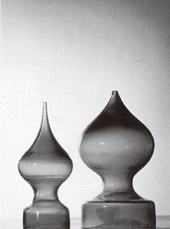
Bertil
Vallien´s first product at Åfors: Sugar and Salt
(Socker och salt), 1960.

Dragoon,
1964.
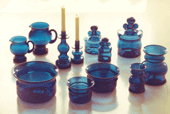
Still
life with blue glass, 1965.
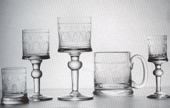
Hussar,
1965.
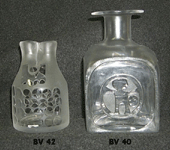
BV
42 och BV 40, sandblasted, 1964.
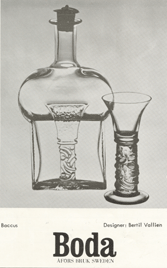
Baccus,
1966.
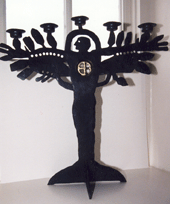
Wrought
iron.
|


